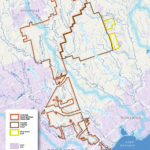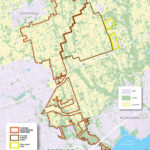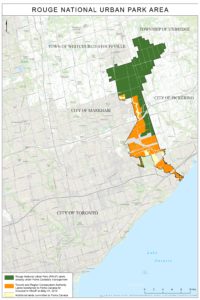Rouge National Urban Park Now 95% Complete!
On June 15, 2019, Parks Canada and the Toronto Region and Conservation Authority (TRCA) announced that TRCA has transferred 18.5 km2 of lands to Parks Canada to become part of Rouge National Urban Park. The announcement was made at Wildlands League’s 6th annual Paddle the Rouge event.
Previously Ontario transferred and released its interest in 22.8 km2 of lands (details here) and Transport Canada transferred 21km2 of land to Parks Canada to help complete Rouge National Urban Park. These are important connected lands and we are thrilled the park will be bigger.
Rouge Park is located on the eastern boundary of the City of Toronto and houses much of the lower Rouge River watershed – one of the last in Western Lake Ontario to remain free of urban development. Bounded by Markham and Scarborough to the west, Pickering to the east and Stouffville to the north, the 47km2 Rouge Park provides a bastion against urban sprawl. It protects a rare Carolinian forest, is home to over 1,700 species of plants and animals, including 23 species at risk, and provides the only protected ecological connection for wildlife between the Oak Ridges Moraine and Lake Ontario in the Toronto area.
Our 6th Annual Paddle the Rouge on 2019 was a huge success. Dignitaries joined Parks Canada, TRCA and Wildlands League. RNUP now 95% complete.
CLICK HERE to watch the video.
MAPS



For a high res version of the maps, please click here and here.
 Why we care
Why we care
A natural stronghold against urban sprawl in the Greater Toronto Area (GTA), Rouge Park is home to over 1700 species of plants and animals including 23 species at risk. The Rouge Valley also contains one of Ontario’s best remaining examples of Carolinian Forest and the last intact watershed in the area. With 7 million ha living within an hour’s drive of Rouge Valley, Rouge National Urban Park is an amazing opportunity to educate Canadians about nature and their numerous special connections to it.
The only wildlife corridor from Lake Ontario to the Oak Ridges Moraine, in the Toronto area, is protected by Rouge Park. Potential commercial and industrial development of the “Pickering Lands” poses a serious risk to species, particularly those that require more space to supply all of their habitat needs (such as otter and Great Blue Heron).
 Solution
Solution
Prioritize Nature:
In such a busy urban landscape, assuring the long-term health of the park will require strong management tools that prioritize conservation and provide clear guidance for visitor use. The law must clearly state that the protection of ecological integrity is the first priority of the Minister in park management. This was achieved in 2017.
Connected lands:
Adjacent to the park are federally owned “Pickering Lands”. If they are developed, one of the last intact wildlife corridors running from Lake Ontario to the Oak Ridges Moraine would be compromised, which would pose a serious problem for wildlife in the Rouge, and in the entire region.
Better intergovernmental cooperation is required to ensure that these “Pickering Lands” remain permanently protected from urban development.
Premier Wynne Paddles the Rouge, June 18, 2017
CPAWS Paddles the Rouge with Prime Minister Justin Trudeau, June 18, 2016
CPAWS applauds bill to fix Rouge National Urban Park Act, June 9, 2016
Bill to Create Canada’s First National Urban Park Remains Flawed, March 12, 2015
Statement by environmental groups urges MPs to reject Rouge National Park legislation, November 18, 2014